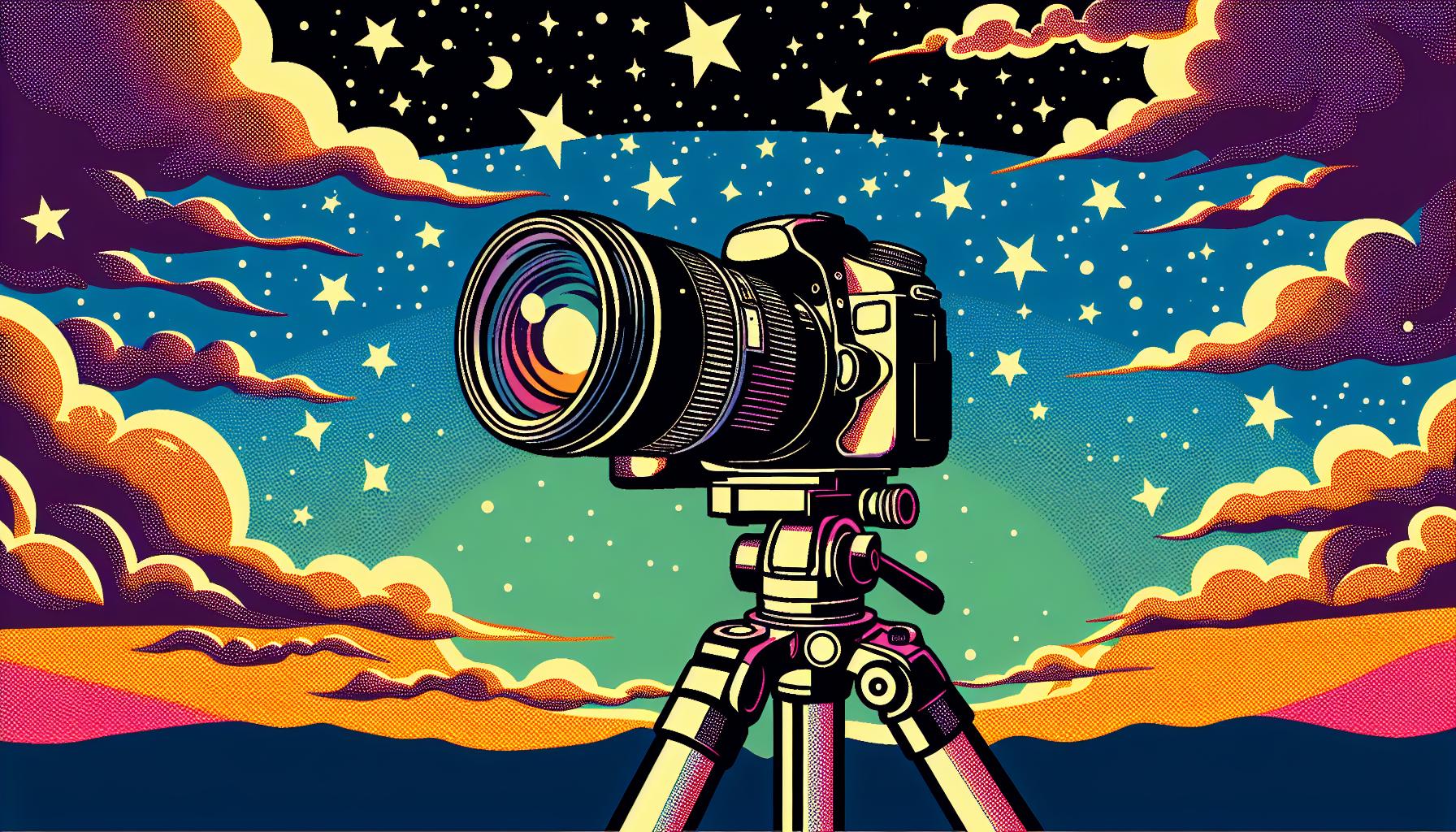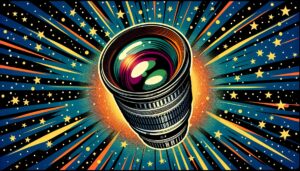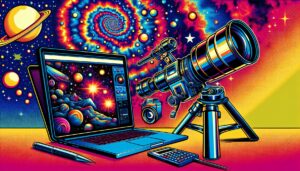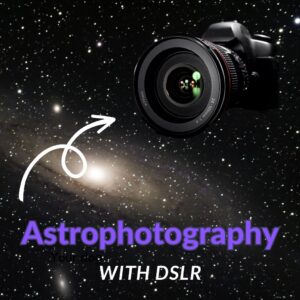This site contains affiliate links to products. I may receive a commission for purchases made through these links.
Astrophotography can seem like a daunting hobby. It’s often associated with expensive equipment and complex tracking systems. But what if I told you it’s possible to capture the stars without all that?
With just a basic DSLR and a tripod, you can start your journey into astrophotography. It’s not about the gear, it’s about understanding and using what you have effectively. In this article, I’ll share my top tips and techniques for successful astrophotography without tracking.
Understanding Astrophotography Without Tracking
Astrophotography without tracking is more than just a matter of pointing your camera at the night sky. The beauty of astrophotography lies in skillfully capturing the intricate details of celestial bodies. This method encourages you to leverage your existing equipment to its fullest, requiring patience, experimentation, and a dedication to learning.
First and foremost, it’s essential to understand your equipment. Knowing your camera’s settings and capabilities are crucial factors. Every DSLR has its unique features and understanding them helps in capturing breathtaking shots.
When using a tripod, stability is the number one priority. A common misconception is that the sturdier the tripod, the better; however, matching the tripod to your camera’s weight is actually crucial. By doing this, you can ensure a stable and balanced base for your astrophotography aspirations.
Mastering manual focus is another key aspect of astrophotography without tracking. Auto-focus is often not reliable for astrophotography due to the low light conditions. Learning to manually adjust your camera’s focus can lead to a world of difference in your images.
Understanding the concept of the “Rule of 500” can significantly improve your outcomes. This rule helps you calculate the longest exposure time before the stars start to ‘trail’ in your image, thus preserving the crispness of your photography.
| Element | Ideal Settings | Why it matters |
|---|---|---|
| Exposure | Depends on your camera and the available light | Overexposure can wash out the details of the sky. Underexposure will make it too dark to see anything |
| Aperture | As wide as possible (low f-number) | Allows more light to reach the sensor, great for capturing dim stars |
| ISO | As low as possible without making the image too dark | Higher ISO increases image noise |
When it comes to astrophotography without tracking, it’s not about expensive equipment or fancy gizmos. It’s all about understanding the beauty of the night sky and how best to use your camera to capture it.
Choosing the Right Equipment for Astrophotography Without Tracking
Continuing our journey into the profound cosmos, we now delve into the important facet of astrophotography without tracking – selecting the appropriate equipment. Remember, underlined in our discussions earlier: it’s not about owning the most expensive equipment, but rather understanding your gadgets and how to use them effectively that truly matters.
First and foremost, choosing the right camera is crucial. Astrophotography requires a camera that performs well under low light conditions. DSLR and mirrorless cameras, particularly with large sensors, are known for their high performance in challenging light situations. I recommend picking a camera that has manual settings, allowing you to have control over aperture, ISO, and shutter speed – variables you’ll often adjust for the perfect starry shot.
Moving forward, let’s shed some light on the importance of a stable tripod. A tripod that is sturdy enough to withstand wind and support the weight of your camera is a non-negotiable tool for astrophotography. Remember, even the slightest movements can cause blurry images of the stars. Tripod stability becomes even more critical when dealing with extended exposure times.
Additionally, your camera lens plays a pivotal role in the quality of your astrophotography images. A wide-angle lens is generally preferred as it covers a larger field of view, thereby capturing more stars. Remember, the wider the aperture (smaller f number), the more light the lens lets in, helping you capture clearer night sky images.
Lastly, astrophotography without tracking means you’re battling against time, trying to capture the magical night sky before stars begin to trail. It’s here where the “Rule of 500” we discussed earlier factors in. A timer or remote trigger could be your best ally in managing exposure time and ensuring you don’t move the camera during shots.
Astrophotography without tracking offers an array of challenges, but with the right equipment and understanding, you’ll soon be capturing the bewitching beauty of the cosmos from your backyard.
Tips for Capturing Stars with a Basic DSLR and Tripod
Tips for capturing the night sky aren’t as elusive as you might think! I’d recommend that any beginner start with a basic DSLR and a sturdy tripod. Not everything hinges on high-priced equipment. Sometimes, it’s your know-how and patience that make all the difference!
It’s crucial to maximize your camera’s settings. The name of the game here is light capture. Beginners often underutilize ISO. It shouldn’t be your first option but don’t neglect it. Boosting your ISO allows your camera to capture more light. Be careful though, a high ISO can also lead to noise in your images.
Let’s get into the nitty-gritty: your camera’s shutter speed. You’ll need a shutter speed that allows you to capture an image without blurring the stars. My top tip: take several test shots to zero in on what works best. Experiment, iterate, and find your ideal settings.
Remember your sturdy tripod? It’s going to come in handy to minimize any vibration. Also, turn on Mirror Lockup or Live View to reduce internal vibrations in the camera.
Choosing the right lens is equally important. A lens with a wide aperture (think f/2.8) allows you to pull in more light. A wide-angle lens can also provide a broader perspective of the night sky.
To avoid shaking the camera during the shot, you can apply a two-second delay or use a remote shutter release. With these in place, trigger your shot without introducing vibration.
Throughout this process, remember to take time to learn. Sometimes astrophotography can feel like a game of patience. Every starry night presents a chance to practice and perfect your craft!
Here’s a quick rundown of the tips:
- Maximize your DSLR’s settings.
- Utilize ISO effectively, but cautiously.
- Experiment with your camera’s shutter speed.
- Use a tripod and the camera’s internal settings to reduce vibration.
- Choose a lens that suits your needs.
- Apply a delay or use a remote shutter to avoid introducing vibration.
Stick with these tips and pretty soon, you’ll be capturing the night sky with mesmerizing detail. Trust me, there’s nothing quite like having the cosmos at your fingertips in your very own photographs.
Mastering Exposure Settings for Astrophotography Without Tracking
Mastering the exposure settings for astrophotography without tracking can seem daunting at first. However, I’ve found that understanding key camera settings like ISO, shutter speed, and aperture makes incredible star shots achievable.
ISO determines your camera’s sensitivity to light. For astrophotography, a higher ISO setting – usually around 1600 to 3200 – is essential. This helps to capture faint stars and galaxies in the sky. That said, pushing the ISO too high can lead to noisy or grainy images. It’s all about finding the sweet spot for your setup.
Shutter speed is also critical. This controls how long your image sensor is exposed to light. For static star images, I generally use a shutter speed of around 20-30 seconds. Any longer, and you’ll start to see star trails because of the Earth’s rotation. Experiment with different settings to uncover what works best on your specific camera setup.
But don’t forget about the aperture, it’s an equally important player. As a rule of thumb, I aim for the widest possible setting on my lens. We’re dealing with extremely dim light, after all. However, I also know going too wide can sometimes lead to softer images. As with everything else in astrophotography, it’s a fine balance.
Mastery over these settings could be the difference between a good shot and a great one. But remember, practice is key. Every clear night is another chance to fine-tune your setup and experiment with your camera’s capabilities. Don’t let technical terms and settings intimidate you. Take advantage of every opportunity to learn and grow in your astrophotography journey.
Having the correct tools and knowledge at your disposal can greatly enhance your photography experience, but there’s something to be said for trial and error. I encourage you all to never stop learning, never stop experimenting. Each star-filled sky is a new opportunity, and who knows, you may discover the next great cosmic phenomenon.
Overcoming Challenges and Maximizing Results in Astrophotography Without Tracking
Now that we’ve covered the importance of ISO, shutter speed, and aperture, let’s discuss overcoming the challenges that come with astrophotography, particularly without a tracking system. Without tracking, the goal is to maximize the quality of images you capture with the limitations of your gear.
Avoiding Star Trails
Avoiding star trails is often challenging when working without a tracking system. With the Earth’s rotation, long exposure times can cause the stars to streak across your image, resulting in star trails.
To avoid this, a common rule used by photographers is the “500 rule”. It’s a formula that helps you calculate the optimum shutter speed for your specific lens and camera. You simply divide 500 by your lens’ focal length (in mm). For example, using a 50mm lens on a full-frame camera, you’d end up with a maximum shutter speed of 10 seconds.
Dealing with Noise
Another significant challenge is managing noise in your images, especially when using a higher ISO setting. As mentioned earlier, a high ISO setting, say around 1600 – 3200, will enable us to capture faint stars and galaxies. However, pushing the ISO too much could make your images noisier.
Astrophotographers often use a method called “stacking” to address this problem. In stacking, you take multiple shots of the same scene and stack them in post-processing. This can significantly reduce noise, but will require a bit more time and effort in editing.
Balancing the Aperture
Finding the right balance for your aperture is also crucial. Shooting at your lens’ maximum aperture allows more light into the sensor, essential in low-light conditions like star photography. However, some lenses may produce softer images at their widest settings. You’ll need to find the sweet spot that allows maximum light while keeping your stars sharp.
Conclusion
Astrophotography without tracking isn’t an unreachable star. It’s all about mastering your camera’s settings and understanding the night sky. With a basic DSLR and tripod, you can capture the cosmos in all its glory. Remember, it’s vital to strike the right balance with ISO, shutter speed, and aperture. Don’t let the fear of star trails or noisy images deter you.
Use the 500 rule to your advantage and harness the power of stacking during post-processing. It may seem daunting at first, but with patience and practice, you’ll soon be shooting the stars like a pro.
So, keep experimenting, keep learning, and most importantly, keep looking up. The universe is waiting for you to capture its beauty.




